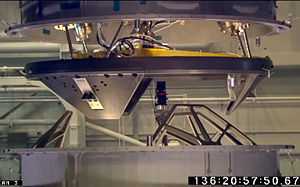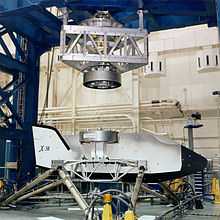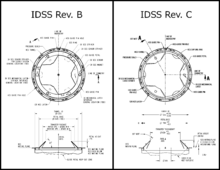NASA Docking System

.png)
The NASA Docking System (NDS) is a spacecraft docking and berthing mechanism being developed for future US human spaceflight vehicles, such as the Orion Multi-Purpose Crew Vehicle and the Commercial Crew vehicles. The NDS is NASA’s implementation of the International Docking System Standard (IDSS), an attempt by the ISS Multilateral Coordination Board (MCB) to create an international spacecraft docking standard. NDS is also known as the international Low Impact Docking System (iLIDS).[1]
Two International Docking Adapters (IDA) will be attached to the ISS' Pressurized Mating Adapters (PMA), one at Node-2 forward, the other at Node-2 zenith.[2] These will convert the Androgynous Peripheral Attach System-95 (APAS-95) to the NASA Docking System.[2] The IDAs are scheduled to be delivered to ISS by the Dragon spacecraft on separate Commercial Resupply Services missions in 2015.[3]
Design
The NDS docking mechanism is androgynous, the first system to use low impact technology and the first system to allow both docking and berthing.[4] It supports both autonomous and piloted dockings and features pyrotechnics for contingency undocking. Once mated the NDS interface can transfer power, data, commands, air, communication and in future implementations will be able to transfer water, fuel, oxidiser and pressurant as well.[1] The passage for crew and cargo transfer has a diameter of 800 millimetres (31 in).[5]
In form and function NDS bears some resemblance to the APAS-95 mechanism already in use on the PMAs attached to the International Space Station, but is not completely compatible with it.
History

In 1996, Johnson Space Center (JSC) began development of the Advanced Docking Berthing System,[6] which would later be called the X-38 Low-Impact Docking System.[7][8] The X-38 was canceled in 2002, development of the mating system continued but its future was unknown.[6] In 2004, George Bush announced his Vision for Space Exploration and NASA's 2005 Exploration Systems Architecture Study was created in response, recommended the use of the Low Impact Docking System (LIDS) for the Crew Exploration Vehicle (which was later named Orion) and all applicable future exploration elements.[9] The Hubble Space Telescope received the Soft-Capture Mechanism (SCM) on STS-125.[10] The SCM is meant for unpressurized docking, but uses the LIDS interface to reserve the possibility of an Orion docked mission.[10] The docking ring is mounted on Hubble's aft bulkhead.[10] It may be used for safely de-orbiting Hubble at the end of its service lifetime.[10]

In February 2010, the LIDS program became modified to be compliant with the IDSS and became known as the international Low Impact Docking System (iLIDS) or simply the NASA Docking System (NDS).[4] In May 2011, the NDS critical design review was completed and qualification was expected to be completed by late 2013.[2]
In April 2012, NASA funded a study to determine if a less complex docking system could be used as the NASA Docking System that both met the international community’s desire for a narrower soft capture system ring width, as well as providing the ISS a simpler active docking system compared to the then-planned design.[11] Boeing's proposal was the Soft Impact Mating and Attenuation Concept (SIMAC), a design originally conceived in 2003 for the Orbital Space Plane (OSP) Program.[11]
A leaked NASA internal memo from November 2012, stated that SIMAC had been chosen to replace the previous design and that the majority of the work on the NASA Docking System would be shifted from NASA JSC to Boeing.[12] Following this change the IDSS was modified, so the new design of the NASA Docking System is still compatible with the standard.[11][13][14] In August 2014, Boeing announced that the critical design review for the redesigned NDS had been completed.[14]
As of 2014, IDA-1 is scheduled to be launched on SpX CRS-7 and IDA-2 on SpX CRS-9.[15]
References
- ↑ 1.0 1.1 Parma, George (2011-05-20). "Overview of the NASA Docking System and the International Docking System Standard" (PDF). NASA. Retrieved 11 April 2012.
- ↑ 2.0 2.1 2.2 Bayt, Rob (2011-07-26). "Commercial Crew Program: Key Drving Requirments Walkthrough". NASA. Retrieved 27 July 2011.
- ↑ "Dragon C2, CRS-1,... CRS-12". Gunter's Space Page. Retrieved 2014-01-17.
- ↑ 4.0 4.1 NASA Docking System (NDS) Technical Integration Meeting (2010-11-17)
- ↑ "NASA Docking System (NDS) Interface Definitions Document (IDD) JSC-65795 Revision C November 2010" (PDF). NASA Technical Reports Server. NASA. Retrieved July 19, 2014.
- ↑ 6.0 6.1 Low Impact Docking System (2009-02)
- ↑ Advanced Docking/Berthing System - NASA Seal Workshop (2004-11-04)
- ↑ Advanced Docking Berthing System
- ↑ NASA's Exploration Systems Architecture Study - 5.3.4 Docking Mechanism/ISS Docking Module Trades (November 2005)
- ↑ 10.0 10.1 10.2 10.3 NASA (2008). "The Soft Capture and Rendezvous System". NASA. Retrieved May 22, 2009.
- ↑ 11.0 11.1 11.2 Pejmun Motaghedi and Siamak Ghofranian. "Feasibility of the SIMAC for the NASA Docking System" (PDF). Boeing. Retrieved 27 September 2014.
- ↑ Johnson Space Center (2012-11-13). "NASA Decides to Adopt Boeing SIMAC Design for Docking and Is Retiring the iLIDS Design". SpaceRef. Retrieved 15 November 2012.
- ↑ "International Docking System Standard Interface Definition Document Rev. C" (PDF). ISS Multilateral Coordination Board. 20 November 2013. Retrieved 28 September 2014.
- ↑ 14.0 14.1 "Boeing Continues Progress on Improved Space Station Docking System". Boeing. 28 August 2014. Retrieved 28 September 2014.
- ↑ Hartman, Daniel (July 2014). "Status of the ISS USOS" (PDF). NASA Advisory Council HEOMD Committee. Retrieved 26 October 2014.
- James L. Lewis, Advanced Docking Berthing System. NASA technical publication. Johnson Space Center.
- James L. Lewis, Monty B. Carroll. Prototype Low Impact Docking System. NASA technical publication.Johnson Space Center.
External links
- NASA Docking System (NDS) Interface Definitions Document (IDD) JSC-65795 Revision C November 2010
Note paper copies of this document went to Revision F in December 2011
| ||||||||||||||
